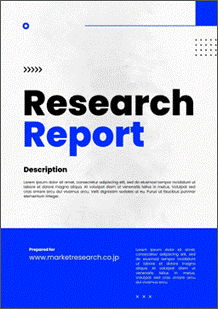 | • レポートコード:MRC2302D077 • 出版社/出版日:Transparency Market Research / 2022年12月20日 • レポート形態:英語、PDF、630ページ • 納品方法:Eメール(受注後24時間以内) • 産業分類:消費財 |
| Single User | ¥869,250 (USD5,795) | ▷ お問い合わせ |
| Multi User | ¥1,319,250 (USD8,795) | ▷ お問い合わせ |
| Corporate License | ¥1,769,250 (USD11,795) | ▷ お問い合わせ |
• お支払方法:銀行振込(納品後、ご請求書送付)
レポート概要
| Transparency Market Research社の本調査資料では、2022年に107億ドルであった世界の産業用ワークウェア市場規模が2031年には195億ドルとなり、予測期間の間に年平均6.3%増加すると展望しています。本資料では、産業用ワークウェアの世界市場について徹底調査し、エグゼクティブサマリー、市場ビューポイント、市場概要、新型コロナウイルス感染症の影響分析、市場分析、市場動向、種類別(トップウェア、ボトムウェア、フットウェア、オーバーオール)分析、適応別(男性用、女性用、ユニセックス用)分析、価格別(低価格、中価格、高価格)分析、地域別(北米、ヨーロッパ、アジア太平洋、中東・アフリカ、南米)分析、市場シェア分析、企業情報、主要インサイトなどを掲載しています。本資料は、3M、Honeywell International Inc.、E. I. du Pont de Nemours and Company、Carhartt, Inc.、VF Corporation、Ansell Ltd.、Fristads Kansas AB、Aramark Corporation、Alsico Group、Portwest、Mascot International A/S、AB Blåkläderなどの企業情報を収録しています。 ・エグゼクティブサマリー ・市場ビューポイント ・市場概要 ・新型コロナウイルス感染症の影響分析 ・市場分析 ・市場動向 ・世界の産業用ワークウェア市場規模:種類別 - トップウェアの市場規模 - ボトムウェアの市場規模 - フットウェアの市場規模 - オーバーオールの市場規模 ・世界の産業用ワークウェア市場規模:適応別 - 男性用ワークウェアの市場規模 - 女性用ワークウェアの市場規模 - ユニセックス用ワークウェアの市場規模 ・世界の産業用ワークウェア市場規模:価格別 - 低価格ワークウェアの市場規模 - 中価格ワークウェアの市場規模 - 高価格ワークウェアの市場規模 ・世界の産業用ワークウェア市場規模:地域別 - 北米の産業用ワークウェア市場規模 - ヨーロッパの産業用ワークウェア市場規模 - アジア太平洋の産業用ワークウェア市場規模 - 中東・アフリカの産業用ワークウェア市場規模 - 南米の産業用ワークウェア市場規模 ・市場シェア分析 ・企業情報 ・主要インサイト |
Industrial Workwear Market – Scope of Report
TMR’s report on the global industrial workwear market studies the past as well as the current growth trends and opportunities to gain valuable insights of the indicators of the market during the forecast period from 2022 to 2031. The report provides revenue of the global industrial workwear market for the period 2017–2031, considering 2021 as the base year and 2031 as the forecast year. The report also provides the compound annual growth rate (CAGR %) of the global industrial workwear market from 2022 to 2031.
The report has been prepared after an extensive research. Primary research involved bulk of the research efforts, wherein analysts carried out interviews with key opinion leaders, industry leaders, and opinion makers. Secondary research involved referring to key players’ product literature, annual reports, press releases, and relevant documents to understand the industrial workwear market.
Secondary research also included Internet sources, statistical data from government agencies, websites, and trade associations. Analysts employed a combination of top-down and bottom-up approaches to study various attributes of the global industrial workwear market.
The report includes an elaborate executive summary, along with a snapshot of the growth behavior of various segments included in the scope of the study. Moreover, the report sheds light on the changing competitive dynamics in the global industrial workwear market. These serve as valuable tools for existing market players as well as for entities interested in participating in the global industrial workwear market.
The report delves into the competitive landscape of the global industrial workwear market. Key players operating in the global industrial workwear market have been identified and each one of these has been profiled, in terms of various attributes. Company overview, financial standings, recent developments, and SWOT are attributes of players in the global industrial workwear market profiled in this report.
RESEARCH METHODOLOGY
The research methodology will be a combination of exhaustive primary and secondary research to analyze the market industrial workwear.
Secondary Research
Secondary research includes a search of company literature, technical writing, patent data, Internet sources, and statistical data from government websites, trade associations, and agencies. This has proven to be the most reliable, effective, and successful approach for obtaining precise data, capturing industry participants’ insights, and recognizing business opportunities.
Secondary research sources that we typically refer, but are not limited to:
Company websites, presentations, annual reports, white papers, technical paper, product brochure
Internal and external proprietary databases and relevant patents
National government documents, statistical databases, and market reports
News articles, press releases, and webcasts specific to companies operating in the market
Specific Secondary Sources:
Industry Sources:
WorldWideScience.org
Elsevier, Inc.
National Institutes of Health (NIH)
PubMed
NCBI
Department of Health Care Service
Trade Data Sources
Trade Map
UN Comtrade
Trade Atlas
Company Information
OneSource Business Browser
Hoover’s
Factiva
Bloomberg
Mergers & Acquisitions
Thomson Mergers & Acquisitions
MergerStat
Profound
Primary Research
During the course of research, we conduct in-depth interviews and discussions with a wide range of key industry participants and opinion leaders. Primary research represents bulk of research efforts, supplemented by extensive secondary research.
We conduct primary interviews on the ongoing basis with industry participants and commentators to validate data and analysis. A typical research interview fulfills the following functions:
Provides first-hand information on market size, market trends, growth trends, competitive landscape, outlook, etc.
Helps in validating and strengthening secondary research findings
Further develops the analysis team’s expertise and market understanding
Primary research involves e-mail interactions, telephonic interviews, as well as face-to-face interviews for each market, category, segment, and sub-segment across geographies
Participants who typically take part in such a process include, but are not limited to:
Industry participants: Marketing/product managers, market intelligence managers, and regional sales managers
Purchasing/Sourcing managers, technical personnel, distributors
Outside experts: Investment bankers, valuation experts, and research analysts specializing in specific markets
Key opinion leaders specializing in different areas corresponding to different industry verticals
List of primary participants, but not limited to:
Advanced Oncotherapy PLC
Danfysik A/S
Hitachi, Ltd.
IBA Worldwide
Mevion Medical Systems, Inc.
Data Triangulation: Information culled from “Secondary & Primary Sources” is cross-checked with “TMR Knowledge Repository”, which is updated every quarter.
Market Estimation: Market size estimations involved in-depth study of product features, technology updates, geographic presence, product demand, sales data (value or volume), historical year-on-year growth, and others. Other approaches were also utilized to derive market size and forecasts. Where no hard data was available, we employed modeling techniques in order to produce comprehensive datasets. A rigorous methodology has been adopted, wherein the available hard data are cross-referenced with the following data types to produce estimates:
Demographic Data: Healthcare expenditure, inflation rates, and others
Industry Indicators: R&D investment, technology stage, and infrastructure, sector growth, and facilities
Market Forecasting: Market forecasts for various segments are derived taking into account drivers, restraints/challenges, and opportunities prevailing in the market and considering advantages/disadvantages of segments/sub-segments over other segments/sub-segments. Business environment, historical sales pattern, unmet needs, competitive intensity, and country-wise surgery data are some of the other pivotal factors, which are considered to derive market forecasts.